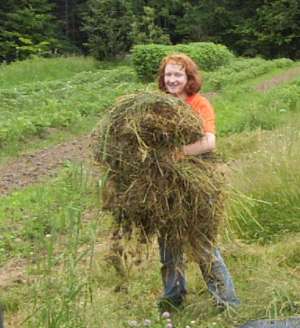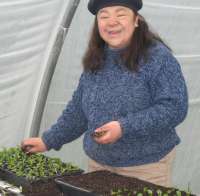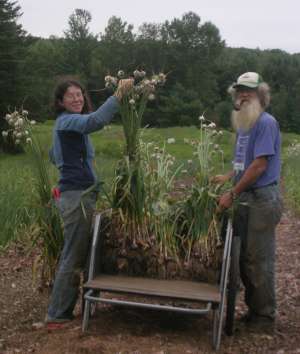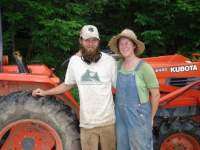![[Snakeroot Organic Farm logo]](pix/sof.gif)
At dawn
Canoe bow waves are quickly lost
on the shoreside
But go on out of sight
on the lake side.
-1986
The constant swish-swish of skis
On a day long ski.
The constant swish-swish of wiper blades
On a day long drive.
-1990
My dog, trotting barefoot
Steps on a garden slug
And thinks
Nothing of it.
-1999
Word spreads quickly
as I approach the pond.
All becomes quiet.
-1997
Hidden in the vines
a large warted cucumber
jumps out of reach.
A toad!
-1997
Delicate puffs
of marshmallow snow
carefully perched
on a branch,
await the trigger of my hat
to melt their way down my back.
-2010
Deep in the tomato jungle
Fruits of yellow, purple and red
Tell of their readiness
To go to market.
-2010
Sugarin' Chores
Snowflakes hurry through my flashlight beam,
As my boots knead new snow with spring mud,
On my nightly Hajj to keep the boil alive,
For as long as possible until the dawn,
To match the power of the flowing sap,
With my meager evaporator and will.
The prize at the finish line are jars of syrup
And Spring.
-2013
|
Download this document as a PDF file or as an Open Office file. Working at INTRODUCTION
You can find a lot more about us by looking at our web site at www.snakeroot.net/farm. It is fairly extensive, and includes pictures of us, of the farm, and some of our farmers' markets, yearly work schedules, as well as literature we produce for educating the public at the markets. We have no livestock. Work at the farm consists of greenhouse work (starting seedlings, trellising, watering), field work (planting, transplanting, weeding, hoeing, watering, harvesting), attending farmers' markets, and generally helping out around the place. A more complete description of what we do during the year can be found at Our Work Schedule.  We'd like to know a little about the folks who are applying to work at
our farm for the coming season. Please feel free to write us about
yourself, and if you think we missed any details.
We'd like to know a little about the folks who are applying to work at
our farm for the coming season. Please feel free to write us about
yourself, and if you think we missed any details.
PAID HOURLY WORK This is for those who wish to work either occasionally or regularly, and
commute from home. You fill in a time card for each day you work. We
develop a work schedule that meets both of our needs, and expect you to
stick to it since we'll be depending upon your help at various times.
Our season for hiring hourly workers is from April to November. SUMMER INTERNS A summer internship is designed for students looking for summer work. We
are looking for people who ideally are willing to start early in the
season and stay late in the season (April thru November), but we realize
that in most cases this is a dream, so we are flexible on starting and
ending dates. Usually the season that works for most interns is from May
or June (when our work schedule begins to move into high gear) until late
August or September (when work is at its busiest), but determined by the
applicant's schedule. APPRENTICES
Stipend is negotiable. |
 27 Organic Farm Road, Pittsfield Maine 04967 http://www.snakeroot.net/farm owned and operated by Tom Roberts & Lois Labbe Tom: Tom@snakeroot.net (cell) 207-416-5417 or Lois: Lois@snakeroot.net (cell) 207-416-5418 Gardening for the public since 1995. |
|
|

 There are three ways workers are integrated into our
farm:
There are three ways workers are integrated into our
farm:
 Interns get meals and a place to stay, shower and laundry
privileges, and time off as negotiated. The type of work is more
varied than that of hourly workers, and somewhat depends on
initiative and previous experience.
Interns get meals and a place to stay, shower and laundry
privileges, and time off as negotiated. The type of work is more
varied than that of hourly workers, and somewhat depends on
initiative and previous experience. Apprenticeship differ from summer internships in that the work season is
year-round, and the term is multi-year. Previous farming experience,
while highly valued, is not as important at the ability to apply yourself
and to work diligently. We host up to two apprentices at a time.
Apprenticeship differ from summer internships in that the work season is
year-round, and the term is multi-year. Previous farming experience,
while highly valued, is not as important at the ability to apply yourself
and to work diligently. We host up to two apprentices at a time.